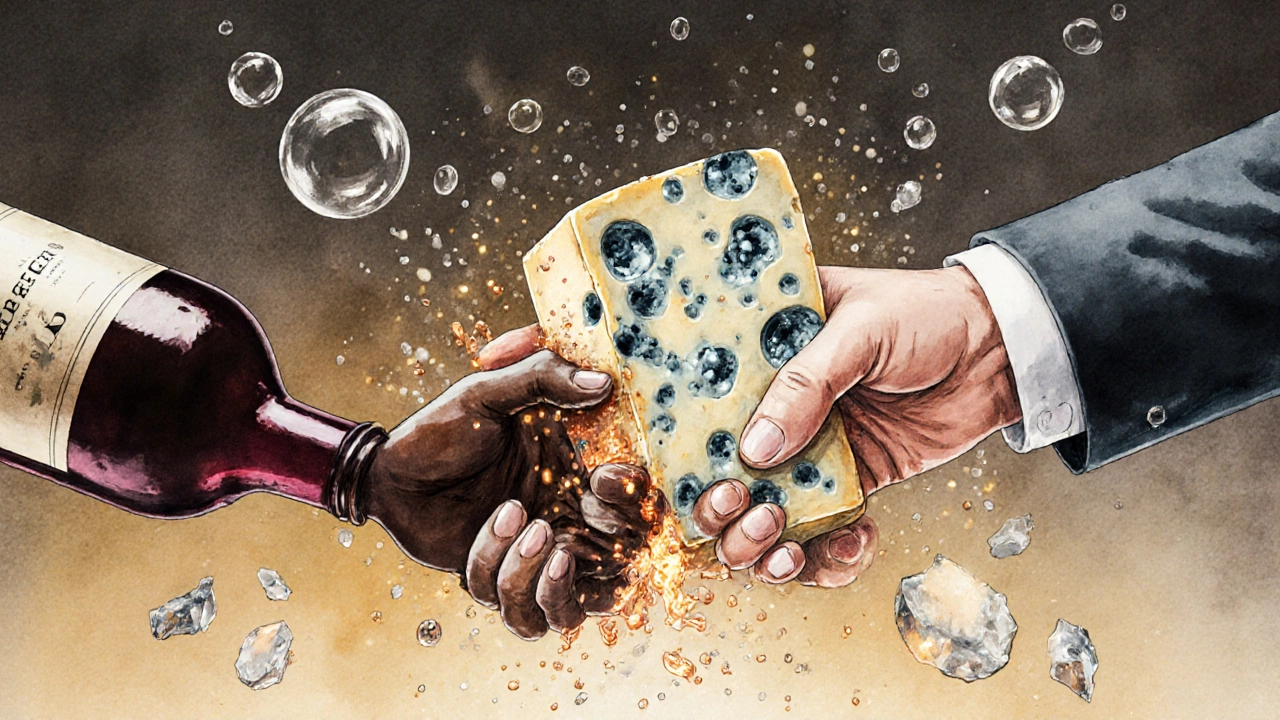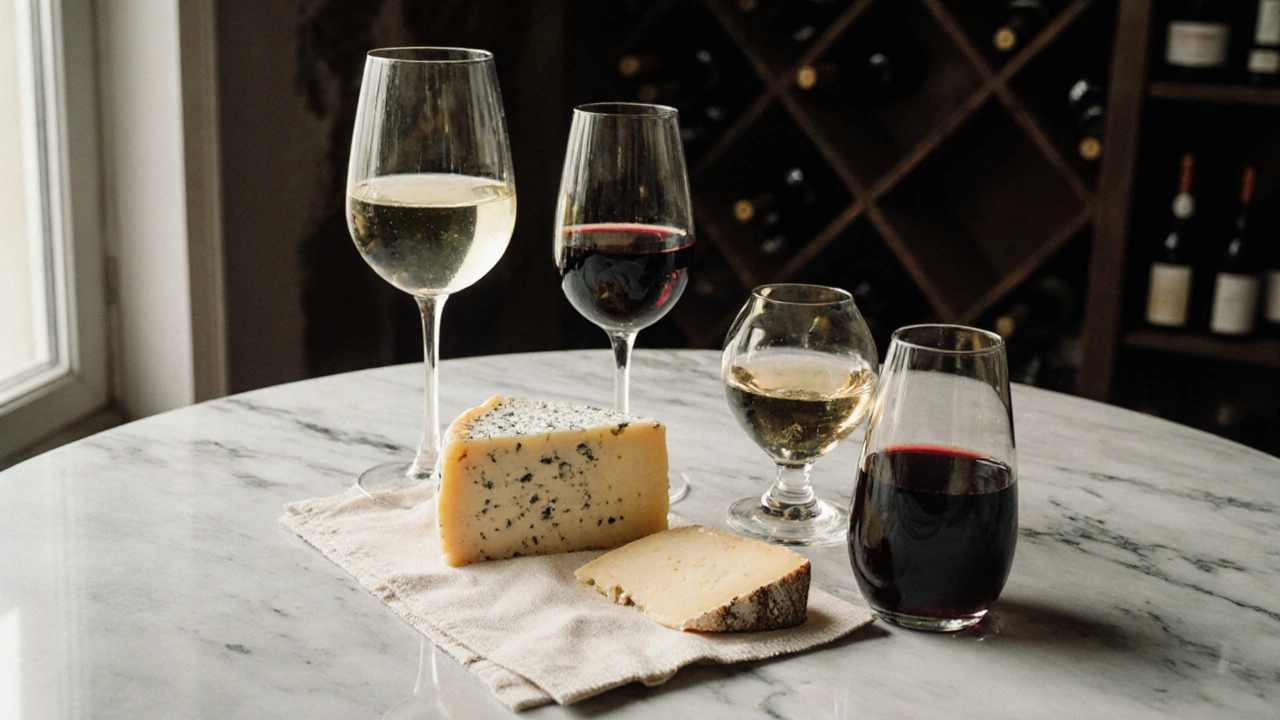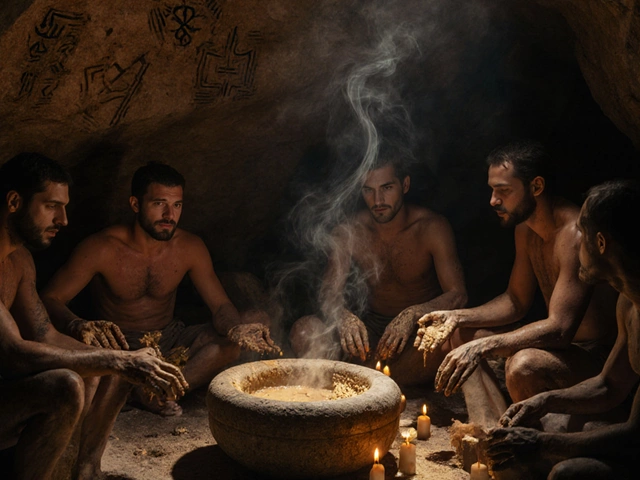Is cheese and wine OK? The short answer is yes-wine and cheese pairing isn’t just tradition, it’s science. But not every combination works. Some make your mouth feel like it’s coated in chalk. Others make the cheese taste like saltwater and the wine like vinegar. The right pairings? They sing together. One bites, the other sings back. It’s not magic-it’s chemistry.
Why Some Pairings Work and Others Fail
Wine and cheese don’t just sit next to each other. They interact. The tannins in red wine bind to the proteins in cheese, softening the wine’s bitterness and making the cheese feel creamier. The fat in cheese coats your tongue, dulling the sharpness of high-acid whites. It’s a chemical handshake.
But if you put a bold Cabernet Sauvignon next to a soft Brie? That’s a clash. The wine’s tannins (2.5-3.5 g/L) have nothing to grab onto in the cheese’s high moisture (50-60%). Instead of balance, you get a metallic, astringent aftertaste. Blind taste tests show only 32% satisfaction with that combo. Meanwhile, the same Cabernet with aged cheddar? 87% satisfaction. Why? The cheese’s low moisture (30-40%) and dense protein give the tannins something to latch onto. The fat melts, the tannins soften, and the flavor lingers clean.
The Four Rules of Thumb (No Fluff)
You don’t need a sommelier degree. Just remember these four rules:
- Match intensity. Light cheese? Light wine. Bold cheese? Bold wine. A fresh goat cheese (70-80% moisture) needs a crisp Sauvignon Blanc (12-12.5% alcohol). A 24-month aged Parmigiano-Reggiano (30-40% moisture) needs a full-bodied Cabernet (13.5-15% alcohol).
- Balance acidity. High-acid wines (7-9 g/L total acidity) cut through fatty or salty cheeses. That’s why Sauvignon Blanc (7.8-9.0 g/L acidity) with goat cheese scores 91% satisfaction. The wine’s zing wakes up the cheese’s tang.
- Counter salt with sweetness. Blue cheeses like Stilton or Gorgonzola have 1.5-2.5g of salt per ounce. That’s too much for dry wines. Sweet wines like Port or sparkling Prosecco balance it. Prosecco with Parmigiano? 89% satisfaction. The bubbles lift the fat; the hint of sugar tames the salt.
- Think regional. If it grew together, it probably pairs well. Comté from France’s Jura? Pair it with Vin Jaune from the same region. Manchego from La Mancha? Try Amontillado Sherry. It’s not coincidence-it’s terroir.
What to Pair With What (No Guesswork)
Here’s what actually works, backed by taste tests, food science, and user reviews:
| Cheese Type | Examples | Best Wine Pairings | Satisfaction Rate |
|---|---|---|---|
| Fresh | Goat cheese, ricotta, cottage cheese | Sauvignon Blanc, Pinot Grigio | 91% |
| Soft | Brie, Camembert, triple-cream | Chardonnay (unoaked), Champagne, Pinot Noir | 85% |
| Semi-Hard | Gruyère, Comté, Fontina | Pinot Noir, Grenache, Rosé | 82% |
| Hard | Aged cheddar, Parmigiano-Reggiano, Pecorino | Cabernet Sauvignon, Syrah, Barolo | 87% |
| Blue | Gorgonzola, Stilton, Roquefort | Port, Sauternes, Prosecco | 84% |
Notice something? Sparkling wine shows up twice-once with hard cheese, once with blue. That’s because carbonation (5-6 atmospheres pressure) cuts through fat like nothing else. It’s the ultimate palate cleanser. That’s why Prosecco with Parmigiano is the #1 recommended pairing at Murray’s Cheese.

The Pairings That Fail (And Why)
Not all combinations are created equal. Here are the top three disasters:
- Oaky Chardonnay + fresh goat cheese: 18% satisfaction. The buttery, vanilla notes of the wine drown out the cheese’s bright tang. It’s like putting honey on lemonade.
- Nebbiolo + Brie: 24% satisfaction. Nebbiolo’s high tannins (3.8-4.5 g/L) have no structure to grip in soft cheese. Result? A chalky, bitter mouthfeel.
- Dry Riesling + blue cheese: 22% satisfaction. Without enough sweetness, the salt overwhelms the wine. It tastes like licking a battery.
These aren’t myths. These are numbers. Wine Enthusiast, Decanter, and user reviews from 14,752 pairings all agree: these combos consistently flop.
How to Start (Even If You’ve Never Paired Before)
You don’t need a cellar. Start with three cheeses and three wines you already have:
- Grab a soft cheese (Brie), a hard cheese (aged cheddar), and a blue (Gorgonzola).
- Open a Sauvignon Blanc, a Pinot Noir, and a Prosecco.
- Taste each cheese with each wine. Write down what you like. Don’t overthink it. Your palate knows more than any guide.
Pro tip: Serve cheese at 65-70°F. Cold cheese tastes flat. Warm it up on the counter for 30 minutes. Serve wine at the right temperature too-light whites chilled (8-10°C), reds slightly cool (16-18°C).
Sequence matters. Go light to bold: fresh → soft → semi-hard → hard → blue. Your palate gets tired if you start with a heavy cheese.

What the Experts Say (No Fluff)
Madeline Puckette, founder of Wine Folly, says: “A bigger, bolder cheese needs a wine that can lift it, spin it around, and not get winded.” She’s not talking about rules. She’s talking about energy.
Will Studd, cheese documentarian, pushes back on tradition: “Many rules are outdated. Modern palates enjoy Cabernet with aged Gouda-temperature control makes it work.” He’s right. Temperature changes everything. A chilled Cabernet next to warm Gouda? It’s magic.
University of California Davis found tannins reduce astringency by 40-60% when paired with cheese. That’s not folklore. That’s lab data.
Is This Just a Trend?
No. The global specialty cheese market hit $58.7 billion in 2023. Premium wine sales? $124.3 billion. Pairing-specific products? A $2.1 billion niche growing 63% a year. Michelin-starred restaurants now have cheese carts with pairing notes. 92% of them do.
It’s not a fad. It’s a sensory language people are learning. And it’s growing fast. The University of California Davis launched the world’s first Wine and Cheese Sensory Science Certificate in January 2024. That’s not a gimmick. That’s a career path.
Final Thought: Rules Are Suggestions
Yes, the science is solid. But your taste is the final judge. If you love a weird combo-say, Riesling with blue cheese-go for it. The future of pairing is less about tradition and more about discovery. The goal isn’t to follow the rules. It’s to find what makes your mouth happy.
Start simple. Taste slowly. Keep notes. You’ll find your own perfect pairings long before you memorize a chart.
Is it okay to pair red wine with cheese?
Yes-especially with hard, aged cheeses like cheddar, Parmigiano-Reggiano, or Gouda. The tannins in red wine bind to the cheese’s proteins and fat, softening the wine’s bitterness and making the cheese taste richer. Avoid reds with soft cheeses like Brie or goat cheese-they clash and leave a metallic taste.
What wine goes best with cheddar cheese?
Aged cheddar (12+ months) pairs best with full-bodied reds like Cabernet Sauvignon, Syrah, or Malbec. The wine’s tannins cut through the cheese’s fat, creating a balanced, lingering finish. For a twist, try a dry Sherry or a bold Zinfandel. Avoid light whites-they’ll taste flat next to the sharpness.
Can you pair white wine with blue cheese?
Only if it’s sweet. Dry whites like Sauvignon Blanc or Chardonnay will taste bitter next to salty blue cheese. Sweet wines like Port, Sauternes, or even a slightly off-dry Riesling balance the salt. Sparkling wines like Prosecco also work-the bubbles lift the fat and cleanse the palate.
Why does cheese make wine taste smoother?
Cheese fat coats your tongue, softening the sharpness of wine acidity and tannins. Wine tannins also bind to cheese proteins, reducing bitterness by 40-60%. This chemical interaction creates a smoother, rounder mouthfeel. It’s not magic-it’s food science.
Should cheese and wine be served cold?
No. Cheese should be served at room temperature (65-70°F) to release its full flavor. Cold cheese tastes dull and salty. Wine should be served at the right temperature for its type: whites chilled (8-10°C), reds slightly cool (16-18°C). Let cheese sit out for 30 minutes before serving.
What’s the easiest wine and cheese combo for beginners?
Sauvignon Blanc with goat cheese. The wine’s bright acidity matches the cheese’s tang, and the combination is fresh, clean, and instantly satisfying. It’s the most popular beginner pairing, with 91% satisfaction in taste tests. It’s hard to mess up.


